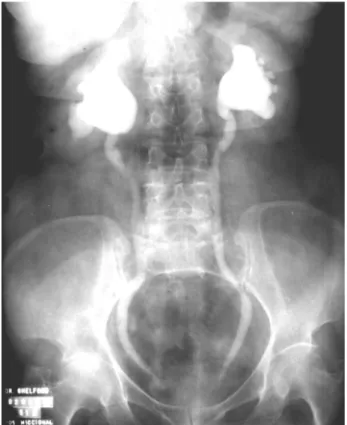243
HYDRONEPHROSIS DUE TO VAGINAL PROLAPSE Case Report
International Braz J Urol
Official Journal of the Brazilian Society of Urology
Vol. 29 (3): 243-244, May - June, 2003
BILATERAL HYDRONEPHROSIS CAUSED BY VAGINAL PROLAPSE
HELIO BEGLIOMINI, BRUNO D. S. BEGLIOMINI
Humanae Vitae Medicine Institute, São Paulo, SP, Brazil
ABSTRACT
Introduction: Even though it is uncommon, uterine prolapse can cause compression of ure-ters and bilateral hydronephrosis, predisposing to arterial hypertension and renal failure. Hydroneph-rosis consequent to cystocele and to vaginal prolapse is even rarer.
Case Report: This paper reports on a 59 year-old patient, Caucasian, obese and hysterecto-mized who presented complete vaginal prolapse with bilateral hydronephrosis and slight alteration in serum urea and creatinine. Patient underwent correction of vaginal prolapse by endoscopic suspen-sion technique with improvement of hydronephrosis and normalization of renal function. This work emphasizes the rarity of such case and the requirement of surgical approach.
Key words: vagina; vaginal prolapse; hydronephrosis Int Braz J Urol. 2003; 29: 243-244
INTRODUCTION
Uterine prolapse can cause dilatation of up-per urinary tract due to ureteral obstruction that, if left untreated, can impair renal function leading to anuria and arterial hypertension (1). Bilateral hydro-nephrosis due to cystocele and, especially, to vaginal prolapse, is very rare.
CASE REPORT
E.F.C.B., 59 years old, Caucasian, widowed, was referred to the Urology Service with vaginal pro-lapse and ultrasonography of urinary tract evidenc-ing bilateral grade II/III hydronephrosis.
As for her antecedents, she reported having 4 pregnancies in the past, with 2 normal deliveries, 1 cesarean and 1 miscarriage. She was hysterectomized by abdominal route 1 year before due to uterine myoma, and on that occasion, a vesical suspension was also performed. She did not present urinary incontinence.
On physical examination, she had a pyknic constitution, was obese and presented a good general
state. Gynecologic examination showed a marked vagi-nal prolapse throughout its entire extension with exco-riations, hyperemia and fissures on the posterior wall of vagina (Figure-1). Laboratory tests showing alter-ation in urea 67.1 mg % (normal < 40 mg %), creati-nine 1.35 mg % (normal < 1.30 mg %) and glycemia 131 mg % (normal < 110 mg %). She did not present urinary infection. The excretory urography confirmed the presence of bilateral hydronephrosis (Figure-2).
Patient underwent an endoscopic colposuspension (3), with good post-operative results within 3 months of follow-up, and improvement of hydronephrosis grade (grade I).
COMMENTS
244
HYDRONEPHROSIS DUE TO VAGINAL PROLAPSE
since there was no uterus, we suspect that obstruction had occurred due to ureteral compression against the pelvic musculature, as well as to ureteral stretching itself, what makes peristaltic movements difficult.
Stress urinary incontinence usually is asso-ciated to small cystoceles. Large cystoceles, associ-ated or not with uterine prolapse, predispose to ob-structive voiding symptoms, chronic residual urine and rarely to bilateral hydronephrosis with potential impairment of renal function. In women presenting dilatation of upper urinary tract one must always rule out, among other causes, uterine or vesical prolapse. Surgical correction either by suprapubic or vaginal approach, intends to resolve the obstructive urinary picture, even though it is known that it can predispose to stress urinary incontinence. When the uterus is present, hysterectomy and vaginal plastic surgery are performed. When there are contraindications to surgery, the pressary can be in-dicated in order to reduce the uterine prolapse (1).
In the case found in literature, it was per-formed the fixation of the vaginal dome in sacral promontory complemented with colpourethropexy in Cooper’s ligament (2). In the case reported here, de-spite the patient being pyknic and obese, with 2 pre-vious surgeries in lower abdomen, the use of vaginal suspension with endoscopic control has shown to be a simple and practical procedure.
REFERENCE
1. Sudhakar AS, Reddi VG, Schein M, Gerst PH: Bilat-eral hydroureter and hydronephrosis causing renal fail-ure due to a procidentia uteri: a case report. Int Surg. 2001; 86:173-5.
2. Delaere K, Moonen W, Debruyne F, Jansen T: Hydro-nephrosis caused by cystocele. Treatment by colpopexy to sacral promontory. Urology. 1984; 24:364-5. 3. Palma PCR, Rodrigues Netto N, Pinotti JA:
Endo-scopic suspension of vaginal vault prolapse. J Bras Urol. 1988; 14:41-2 [in Portuguese].
Received: March 6, 2003 Accepted after revision: May 2, 2003
Correspondence address: Dr. Helio Begliomini Rua Bias, 234
São Paulo, SP, 02371-020, Brazil
Figure 1 – Marked vaginal prolapse throughout its entire extension.
